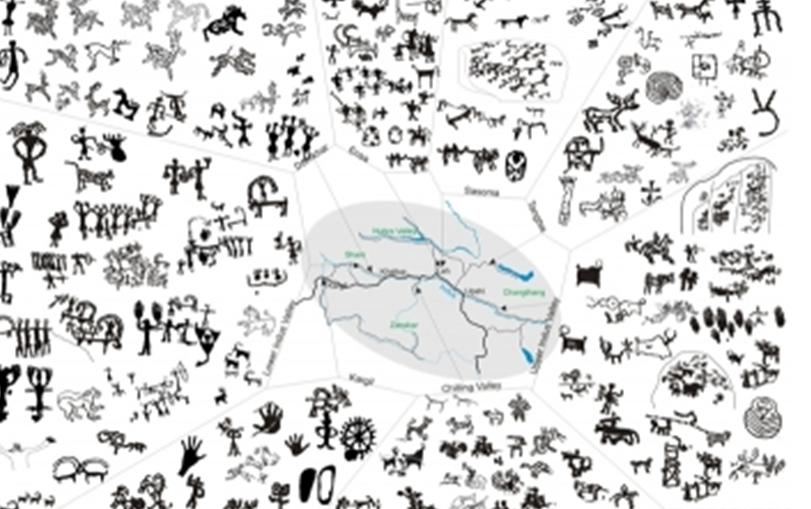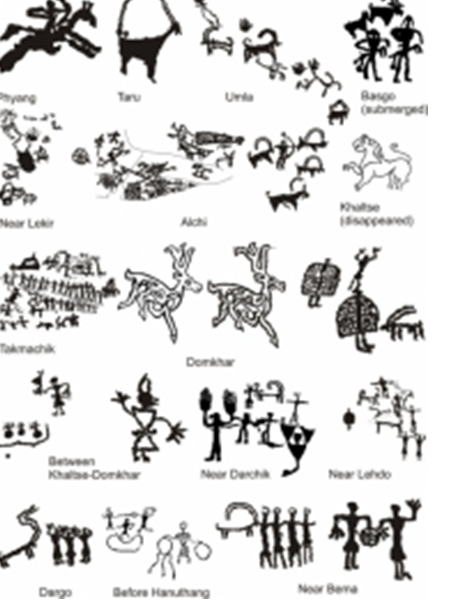Rock Art: Ladakh
This is a collection of articles archived for the excellence of their content. Readers will be able to edit existing articles and post new articles directly |
Rock Art
Ladakh: A potential for an Open Museum of Rock Art part 1
By Tashi Ldawa, Tuesday, June 4, 2013
Leh: Ladakh is getting more and more popular as a tourist destination. And why not: the peculiar landscape, the snow-capped mountains, the high altitude lakes, a different culture, the monasteries and so on make it an ideal tourist destination.
The rock art of Ladakh is one aspect which has a high potential for tourist attraction of a different nature altogether. Rock art is a heritage that we have inherited and many of these arts are more than 3-5 thousand years old. It is in fact the oldest monument to be found in Ladakh, far more than any monasteries. India is said to have third largest concentration of rock art in the world after Australia and Africa. Many of the rock art sites in the world, including India, have successfully tapped rock art as a tourist destination. The rock art of Ladakh (technically classified as petroglyphs) is so widespread throughout Ladakh that we can claim to have largest concentration of petroglyphs in India (if not world). In fact we feel Ladakh could serve as an open museum for rock art. More interestingly, there is a wide range in the subject and style to amaze any one. Many of the elements are Central Asian, while many resemble similarity with the ones found in Northern region of Pakistan and Tibet. So far we have discovered hundreds of sites, thousands of engraved rocks and tens of thousands of figures, throughout Ladakh.
While there are many universal messages in the rock art like celebration, ritual, tradition, hunting etc., yet many of the elements of rock art of Ladakh shows a rare exception in beauty, style and subject. Surely they display much more than archaeologist’s delight, it is worth a public display: for art or history. Given the fact of their antiquity, there is every scope of an open museum of rock art in Ladakh. But till anything is done, for the present, the message is “protect these rock art” they are part of our cultural heritage.
The collection of figure shows just a fraction of figures from different regions of Ladakh. I hope in future volumes I can write articles on rock art of Ladakh region-wise: keep watching.
Tashi Ldawa is an independent researcher on rock since last more than fifteen years. He has attended many national and international conferences on the subject and presently the only local expert on rock art. He is working for protection and conservation too. His book on rock art of Ladakh is likely to be published soon.
Rock Art of Lower Ladakh: Sham Part II
By Tashi Ldawa, Thursday, July 4, 2013
Leh: As I have already mentioned in the previous issue (Part I) that Ladakh has a rich source of rock art in the form of Petroglyphs, enough to be an ‘open museum’. One of the richest sites of rock art is along the river Indus. For convenience, we may divide it as lower and upper Indus, Leh being the dividing point. It depicts the earliest expressions of humankind. It is associated with cultural values. They are irreplaceable records of the artists, his thought and reason for the art he has drawn. Here in Ladakh it could play a vital role in understanding the role played by these mountainous regions as a cultural crossroads from the prehistory to the present day. Phyang, Taroo, Umla, Basgo, Likir, Alchi, Nyurla all have some forms of prehistoric rock art. Some of the rocks in Basgo have been inundated due to the Alchi dam. One of the most important one with Kharoshti inscription near the Khaltse Bridge has been damaged. From Khaltse to Domkhar there are several sites worth noticing. Achinathang has some rock displaying human figures of rare representations. At Domkhar, particularly in the private compound of Thangjuk family lies one of the most beautiful forms of animal representations, a clear Central Asian art of more than two thousand years old. A scholar of rock art writes about this site as “This site is indeed a true gold mine for scientists and a possible key to better understand the ancient past of the lower Indus valley and thus potentially throw light on the ancient history of Ladakh, which up to present remains almost unknown”. There are also some Chinese inscriptions. The family has now made it a Rock Art Heritage Garden for visitors to enjoy. From Domkhar to Batalik there are another not less than dozen sites, each displaying some unique subject and forms. Near Bema, there is a large boulder with hundreds of figures, along with some Kharoshti inscriptions. At another site we have discovered pictograph (painting on the rock) which is rare to be found in Ladakh, it is yet to be studied in detail. Only some of these rock art has been studied, and few of them have been dated to around three thousand BC. This cultural heritage as we have seen has been neglected and at many places they have been destroyed and damaged. We still have time to protect these rocks or else they may disappear forever. There are about half a dozen of scholars (foreigners) who are studying, but I feel, we as a Ladakhi have the responsibility to protect them and be proud of these rare and historically significant art: equally as any other monuments.

